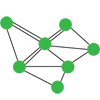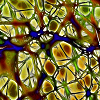These teaching resources have the primary aim of showing how maths can be used to understand epidemics, social interactions and vaccination.
Introduction
Students may have learnt in science lessons about how infectious disease spread, but may not have considered the dynamics of their spread, and how maths can be used for such analysis. As such, these resources provide a cross-curricular activity set, and may be used in conjunction with science departments.

Although the focus of these series of activities is to show everyday applications of school mathematics in the context of infectious disease control, they also consider the ethical concerns of data collection, as well of disease control more generally, to show that this field goes beyond that of just mathematics and biology.
As part of a public engagement research project, these resources have been developed alongside and trialled with students from years 8-10 (ages 12-15), although some of them may be suitable for younger or older students too. Read all about it in the Plus article School students help researchers fight diseases.
How to use these resources
The activities included in this collection vary from small group activities to those which can be done by the whole class together. They can be mixed and matched accordingly, depending on the requirements of the class, and what prior knowledge they may have.
Most of the resources do not require anything more than the slides included, and some paper for the students to do their workings on. One activity requires chess boards and two different coloured counters, and one activity requires dice.

Investigating epidemics
Simple models which help us to investigate how epidemics grow and die out.

The standing disease
This short activity encourages students to consider how diseases spread exponentially in an unvaccinated population.

R0 game
This short activity explores how $R_0$, the reproduction number, affects the spread of disease in an unvaccinated population.

Vaccination game
This activity encourages students to consider the effect of vaccination on the spread of a disease.

Disease dilemmas
This activity encourages students to consider ethical questions relating to disease outbreaks, and to explore the difficulties of combatting infectious diseases.

Epidemics on networks
This activity introduces students to networks, and enourages them to consider these in the context of social networks and diseases.

Analysing networks
This activity encourages students to consider different ways of interpreting data about networks, and what this means in the context of disease.

Anonymity game
This short activity encourages students to consider the risks associated with insecure data collection, including how identities can be reconstructed from partial data.

Friendship paradox
This short activity encourages students to consider a surprising result about the average number of friends that people have.
Context
As mathematical modellers of infectious disease, the designers of these resources have an interest in the control and transmission of infectious disease - such as influenza - from person to person. For these, and for many other infections, school students are especially important as they come into contact with lots of other students, and they often have not yet built up immunities to disease. Therefore, understanding how they interact with each other at this level is vital. As such, the researchers think it is also important for the school students themselves to understand these social networks, and to show the types of analyses that can be used to understand disease dynamics.
We hope that these resources will spark an interest in our field of research - and show a further real world application of mathematics to school-aged students.
These teaching resources have been developed as part of a research project run jointly between the London School of Hygiene & Tropical Medicine, Millennium Maths Project, University of Cambridge and 4 UK schools (Highgate School London, St Pauls Catholic College, Sussex, The Lakes School, Windermere and St Bonaventure's Catholic Comprehensive School, Newham), whilst working with Year 9 students to understand how social networks change over the course of an academic year, and what effect this might have on the spread of disease. Funding for the development of these resources came from a Wellcome Trust People Award.
